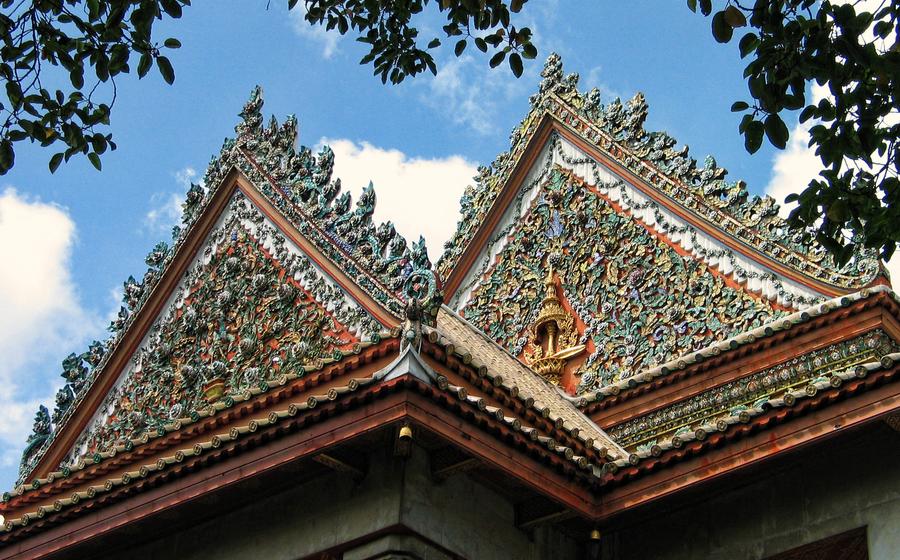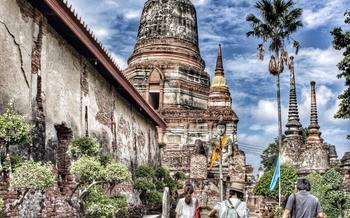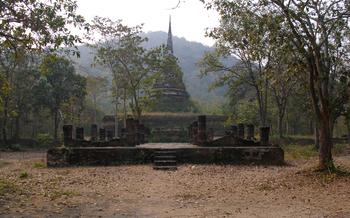
Wat Bowonniwet Vihara
- The Wat Bowonniwet Vihara: A Haven of Serenity in Bangkok's Bustle
- The Ordination Hall and Buddha Images
- The Relics of the Lord Buddha
- The Monastic Quarters and Daily Life
- Wat Bowonniwet Vihara as a Center of Education
- The Temple Museum and Its Treasures
- The Temple's Role in Royal Ceremonies
- The Temple Fair and Festive Celebrations
- Visiting Wat Bowonniwet Vihara: Practical Tips
- Nearby Attractions and Points of Interest
- Getting to Wat Bowonniwet Vihara
- Insider Tip: Hidden Gem
The Wat Bowonniwet Vihara: A Haven of Serenity in Bangkok's Bustle
Nestled amidst the vibrant tapestry of Bangkok's cityscape, the Wat Bowonniwet Vihara stands as an oasis of tranquility, a sacred sanctuary where spirituality and history intertwine. Founded in the early 19th century by Prince Mongkut, who later became King Rama IV, this magnificent temple holds a prominent position not only in the annals of Thai Buddhism but also in the hearts of the Thai people.
With its awe-inspiring architecture, serene atmosphere, and profound spiritual significance, the Wat Bowonniwet Vihara has become a must-visit destination for both pilgrims and tourists alike. As you step through its gates, you will be transported into a realm of tranquility, where the cacophony of city life fades away, replaced by the gentle chanting of monks and the soft rustling of leaves in the breeze.
The temple's architectural design is a testament to the grandeur and artistry of the Rattanakosin era. Its gleaming white stupas, intricate carvings, and colorful murals captivate the eyes, while the meticulously landscaped gardens and serene ponds create a sense of harmony and balance. The temple's unique features, such as the towering prang (spire) and the magnificent ubosot (ordination hall), set it apart from other temples in Bangkok, making it a truly remarkable sight.
As a spiritual center, the Wat Bowonniwet Vihara holds immense significance for Thai Buddhists. It serves as a place of worship, meditation, and spiritual guidance for both monks and laypeople. Throughout the day, the temple's halls resonate with the melodious chanting of monks as they perform their daily rituals and prayers. Visitors are welcome to join in these ceremonies or simply observe from a distance, gaining a deeper understanding of Thai Buddhist practices.
The Ordination Hall and Buddha Images
The ordination hall at Wat Bowonniwet Vihara holds immense significance in Buddhist tradition. It serves as a sacred space where young men formally renounce their worldly lives and embrace the path of monasticism. The ordination ceremony, known as "upasampada," is a profound and transformative ritual that marks the beginning of a monk's spiritual journey.
Within the ordination hall, visitors can marvel at exquisite Buddha images that exude an aura of serenity and divinity. The central Buddha image, known as "Phra Buddha Chinnarat," is a replica of the highly revered Buddha statue enshrined at Wat Phra Si Rattana Mahathat in Phitsanulok. This image is believed to possess miraculous powers and is deeply revered by Thai Buddhists.
Other notable Buddha images in the ordination hall include "Phra Buddha Trairatnaraj," a three-headed Buddha representing the three jewels of Buddhism: the Buddha, the Dharma, and the Sangha. The "Phra Buddha Sihing" image is also of great significance, believed to have been created during the reign of King Ashoka in India and brought to Thailand in the 13th century.
When visiting the ordination hall, visitors are expected to observe proper conduct and respect. It is customary to remove one's shoes before entering the hall and to maintain silence to create a peaceful atmosphere conducive to meditation and spiritual contemplation.
The Relics of the Lord Buddha
The Wat Bowonniwet Vihara holds a profound significance as it enshrines relics of the Lord Buddha, revered as sacred remnants of the enlightened teacher. The discovery of these relics is shrouded in mystery and legend, adding to their spiritual allure. Enshrined within a magnificent stupa, the relics draw countless pilgrims and devotees seeking blessings and paying homage to the Buddha's teachings.
The presence of the relics transforms the temple into a sacred pilgrimage site, attracting followers from across the globe. Visitors are granted the opportunity to pay homage and offer prayers, experiencing a deep sense of reverence and connection to the Buddha's legacy. The stupa housing the relics exudes an aura of serenity, inviting visitors to immerse themselves in contemplation and reflection.
The relics serve as a powerful reminder of the Buddha's teachings on compassion, wisdom, and liberation from suffering. They inspire devotees to lead virtuous lives, guided by the principles of the Dhamma. The enshrinement of the relics at Wat Bowonniwet Vihara further reinforces its status as a prominent center of Buddhist devotion and spiritual enlightenment.
The Monastic Quarters and Daily Life
Within the serene confines of Wat Bowonniwet Vihara, a community of dedicated monks resides, their lives intricately interwoven with the temple's spiritual essence. Adhering to the principles of Buddhist teachings, these monks lead a disciplined and devoted existence, guided by the teachings of Lord Buddha.
Their daily routine commences at dawn, as the temple's bells gently chime, signaling the start of the day's prayers and meditation sessions. The monks gather in the temple's serene meditation hall, their chants reverberating through the tranquil space, creating an atmosphere of profound devotion.
Throughout the day, the monks engage in various religious activities, including the study of Buddhist scriptures, the practice of mindfulness, and the performance of rituals and ceremonies. They also tend to the temple's upkeep, ensuring its pristine condition and welcoming ambiance.
Visitors to the temple have the rare opportunity to witness glimpses of the monks' daily lives, observing their unwavering dedication to their faith and the teachings of Lord Buddha. The monks welcome respectful interactions with visitors, offering insights into their spiritual practices and the temple's rich history.
Interaction with the monks is not only a cultural exchange but also an opportunity for personal reflection and growth. Visitors may seek guidance on meditation techniques, inquire about Buddhist teachings, or simply engage in meaningful conversations about spirituality and the pursuit of inner peace.
Wat Bowonniwet Vihara as a Center of Education
Wat Bowonniwet Vihara has a long-standing tradition of education and is renowned as a center of Buddhist learning. In 1949, the temple established the Buddhist University, which has become a prestigious institution of higher education. The university offers a diverse range of courses and programs in Buddhist studies, Thai culture, and related fields. It attracts students from Thailand and around the world who seek to deepen their understanding of Buddhism and its teachings. The university's faculty comprises experienced monks and scholars who are dedicated to preserving and promoting Buddhist knowledge. Wat Bowonniwet Vihara's commitment to education extends beyond the university. The temple also hosts regular classes, workshops, and seminars on Buddhist topics, open to both monks and laypeople. These educational initiatives play a vital role in preserving and transmitting Buddhist teachings to future generations.
The Temple Museum and Its Treasures
Nestled within the serene grounds of Wat Bowonniwet Vihara lies a treasure trove of history and culture – the temple museum. Established to preserve and showcase the rich heritage of Thai Buddhism, the museum houses a diverse collection of artifacts, relics, and artworks that offer visitors a glimpse into the kingdom's spiritual and artistic traditions.
Among the museum's prized possessions are ancient Buddha images, each exquisitely crafted and exuding a sense of profound devotion. These statues, dating back centuries, represent various artistic styles and periods, providing a visual journey through the evolution of Thai Buddhist iconography.
In addition to the Buddha images, the museum also houses a collection of historical relics, such as ancient manuscripts, religious texts, and royal artifacts. These objects provide valuable insights into the history and development of Thai Buddhism, as well as the close relationship between the monarchy and the temple.
For those interested in Thai art and culture, the museum offers a fascinating array of traditional paintings, sculptures, and decorative objects. From intricate wood carvings to delicate murals, these artworks showcase the skill and artistry of Thai craftsmen throughout the ages.
The temple museum is a must-visit for anyone seeking a deeper understanding of Thai Buddhism and its cultural significance. Through its collection of artifacts, relics, and artworks, the museum provides a unique and immersive experience that transports visitors back in time to explore the rich history and traditions of this ancient religion.
The Temple's Role in Royal Ceremonies
Wat Bowonniwet Vihara holds a significant place in the history and traditions of the Thai monarchy. Throughout the years, the temple has been the venue for various important royal ceremonies and events, reflecting its close association with the royal family.
One of the most notable ceremonies held at the temple is the Royal Kathin Ceremony, an annual event that marks the end of the Buddhist Lent period. During this ceremony, the King or a representative from the royal family presents new robes to the monks at Wat Bowonniwet, symbolizing the royal patronage and support for the Buddhist community.
In addition, Wat Bowonniwet has also served as the site for royal cremations and other significant events in the lives of Thai royalty. These ceremonies are often elaborate and steeped in tradition, showcasing the deep connection between the temple and the monarchy.
By hosting these royal events, Wat Bowonniwet plays a crucial role in preserving and honoring Thai traditions, while also strengthening the bond between the monarchy and the Buddhist faith. Visitors to the temple may have the opportunity to witness or participate in these ceremonies, gaining a deeper understanding of Thai culture and history.
The Temple Fair and Festive Celebrations
Wat Bowonniwet Vihara comes alive during its annual temple fair, a vibrant and joyous event that showcases the best of Thai culture and traditions. Held over several days, usually in February or March, the fair attracts thousands of visitors from all over the country and abroad.
The temple grounds transform into a bustling marketplace, with colorful stalls selling a variety of traditional Thai delicacies, handicrafts, and souvenirs. The air fills with the aroma of sizzling Pad Thai, grilled meats, and sweet desserts, tempting visitors to indulge in a culinary adventure.
Traditional Thai games and activities add to the festive atmosphere. Locals and tourists alike try their hand at bamboo stilt walking, coconut bowling, and other fun games. The temple fair is also a platform for showcasing traditional Thai performing arts, such as classical dance, shadow puppetry, and live music performances.
The temple fair holds great significance in Thai culture, as it is a time for the community to come together and celebrate their shared heritage. It is also an opportunity for visitors to experience the vibrant and welcoming spirit of the Thai people.
To make the most of your visit to the temple fair, come prepared to embrace the lively atmosphere and immerse yourself in the cultural festivities. Be sure to try some of the delicious local food, participate in the traditional games, and enjoy the enchanting performances. Remember to dress comfortably and bring cash, as most vendors may not accept credit cards.
With its vibrant atmosphere, delicious food, and cultural performances, the temple fair at Wat Bowonniwet Vihara is an unmissable experience for anyone visiting Bangkok. Join in the festivities and create lasting memories of your time in Thailand.
Visiting Wat Bowonniwet Vihara: Practical Tips
Best Time to Visit for a Peaceful Experience:
- Early mornings (before 10 am) or late afternoons (after 4 pm) are ideal for avoiding crowds and enjoying a tranquil atmosphere.
Dress Code and Appropriate Attire:
- Respectful attire is expected, covering shoulders and knees. Shorts, tank tops, and revealing clothing are not permitted.
Etiquette and Customs to Observe:
- Remove your shoes before entering the temple buildings.
- Be mindful of your speech and actions, maintaining a respectful demeanor.
- Ask for permission before taking photographs, especially when people are praying.
Accessibility for Visitors with Disabilities:
- The temple grounds are generally accessible, with ramps and elevators available in some areas. However, certain sections may be challenging for wheelchair users.
Navigating the Surrounding Area:
- Walk cautiously on the temple grounds, as some areas may be uneven or slippery.
- Be aware of traffic when crossing roads, as the temple is located in a busy area.
Nearby Attractions and Points of Interest
Wat Bowonniwet Vihara is situated in a vibrant and culturally rich neighborhood, offering visitors a plethora of attractions and points of interest to explore. In close proximity to the temple, one can find a cluster of other historic temples, each possessing its unique charm and architectural style. The nearby Wat Suthat Thepwararam, with its towering prang and intricate murals, is a must-visit for its stunning beauty and religious significance.
Beyond the sacred realm, the area surrounding Wat Bowonniwet Vihara is dotted with museums, art galleries, and cultural attractions that delve into Thailand's rich history and heritage. The Bangkok National Museum, just a short walk away, houses an impressive collection of artifacts and exhibits showcasing the country's diverse cultural traditions and artistic achievements.
For those seeking a taste of local life, the bustling streets surrounding the temple offer a vibrant array of shopping and dining options. From traditional Thai markets selling fresh produce, spices, and handicrafts to trendy cafes and restaurants serving delectable local cuisine, there's something to satisfy every palate and budget.
To make the most of your visit, consider crafting an itinerary that combines the spiritual serenity of Wat Bowonniwet Vihara with the cultural and historical treasures of its surroundings. Whether you're a history buff, an art enthusiast, a foodie, or simply seeking a glimpse into authentic Thai life, this vibrant neighborhood has something to offer.
Getting to Wat Bowonniwet Vihara
Wat Bowonniwet Vihara is conveniently located near several public transportation options, making it easily accessible from different parts of Bangkok.
-
BTS Skytrain: Take the BTS Skytrain to the National Stadium Station and walk approximately 10 minutes to the temple.
-
MRT: Alternatively, take the MRT (subway) to the Sam Yan Station and walk about 15 minutes to the temple.
-
Bus: Several bus lines pass near Wat Bowonniwet Vihara, including buses 15, 40, 48, 50, 59, and 7Get off at the "Wat Bowonniwet" bus stop and walk a short distance to the temple entrance.
-
Taxi: Taxis are readily available in Bangkok and can be a convenient option to reach the temple. Simply provide the taxi driver with the temple's name and address, or show them the Thai translation: วัดบวรนิเวศวิหาร.
-
Private Vehicle: For those driving their own vehicles, Wat Bowonniwet Vihara has limited parking spaces available within the temple grounds. However, finding street parking in the surrounding area can be challenging due to the temple's central location.
To ensure a smooth and enjoyable visit, it's advisable to plan your transportation in advance, especially during peak tourist seasons.
Insider Tip: Hidden Gem
Venture beyond the main temple grounds to discover the serene Buddha Garden, a hidden oasis nestled within the temple complex. This tranquil retreat features a collection of intricately carved Buddha images of various sizes, arranged amidst lush greenery and serene ponds. Take a moment to sit and reflect in this peaceful sanctuary, away from the bustling crowds. It's an ideal spot for photography enthusiasts to capture unique shots of the Buddha images against the backdrop of the tranquil garden. Remember to maintain a respectful demeanor and observe the temple's etiquette when exploring this hidden gem.



